
Hjörleifshöfði Promontory in South-Iceland - the Blood Brothers Ingólfur and Hjörleifur

There are some promontories in South-Iceland, which are of great interest to me. I have already written a travel-blog about the elves in Mt. Pétursey in South-Iceland, but there is another promontory of interest further east, just after you pass the village of Vík. This historical promontory is called Hjörleifshöfði.
Hjörleifshöfði is 221 meters high and towers majestically above the black glacial volcanic outwash, Mýrdalssandur.
Hjörleifshöfði is named after the Viking settler, Hjörleifur Hróðmarsson, the blood brother of Ingólfur Arnarson who is considered to have been our first Viking settler in around 874 AD. Hjörleifur was the second settler of Iceland, but sadly enough he was killed the year after in 875 AD.
Top photo: Hjörleifshaugur burial mound
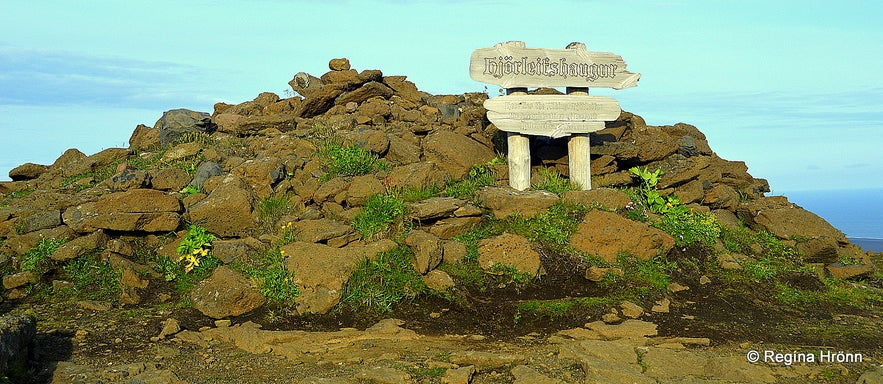
On the highest point of Hjörleifshöfði, you will find the burial mound of Hjörleifur himself - Hjörleifshaugur.
I am going to introduce you to the Vikings Ingólfur and Hjörleifur and tell you what Landnáma - the Book of Settlement of Iceland has to say about the first settler of Iceland and his blood brother. Landnáma was written in the 12th century and the story of Ingólfur and Hjörleifur is told in chapters 3-9.
Landnáma tells us about the bloodline of Ingólfur and Hjörleifur and how they were related. They had the same great-grandfather, Hrómundur Gripsson, so their grandfathers, Björnólfur and Hróaldur were brothers. Björnólfur had the son Örn, the father of Ingólfur and his sister Helga, but Hróaldur had the son Hróðmar, the father of Leifur (Hjörleifur).
Thus the blood brothers Ingólfur and Hjörleifur were second cousins.

Hjörleifshaugur burial mound
Back in Norway Ingólfur and Leifur went on a Viking raid with the sons of the earl Atli – Hásteinn, Hersteinn, and Hólmsteinn. They were friends and decided on going on another Viking raid the following year.
That winter Ingólfur and Hjörleifur threw the sons of the earl a feast. At the feast, Hólmsteinn swore that Helga Arnardóttir would become his wife or else he would not marry. Leifur blushed, seeing that he was in love with his second cousin Helga, the sister of Ingólfur.
Next spring they meant to go on a Viking raid with the sons of the earl, but Hólmsteinn and his brothers attacked Ingólfur and Leifur, which ended in a Viking battle, where Hólmsteinn was killed.
The next winter the other brother, Hersteinn, attacked them in a battle where Hersteinn got killed. As a settlement for killing 2 of the earl‘s sons, Ingólfur and Leifur had to give all of their assets to the earl. (The story is told a bit differently in Flóamanna Saga - there Hásteinn is called Hallsteinn and he ended up having to flee to Iceland. Flóamanna Saga tells his story and the story of his descendants).
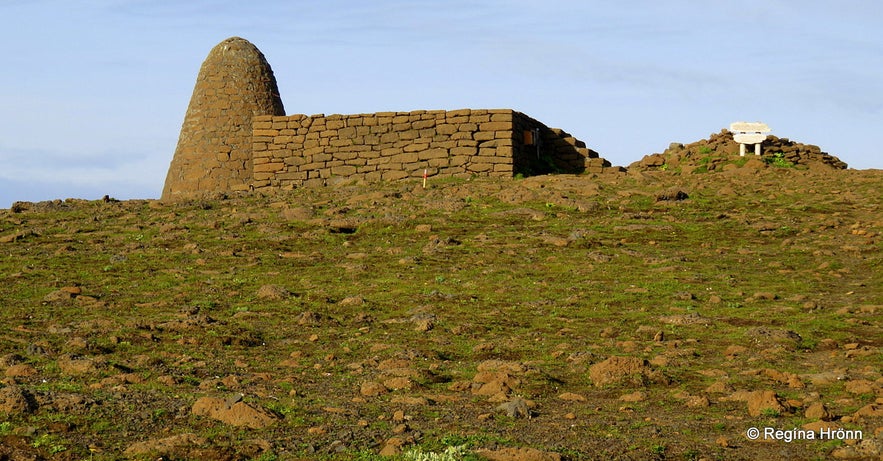
Hjörleifshaugur, the family plot and a big cairn on top of Hjörleifshöfði
Not owning land any longer the blood brothers went by ship looking for the land found by Hrafna-Flóki and which he had named Ísland-Iceland.. They found Iceland and stayed in the Eastfjords in Álftafjörður for one winter, figuring that the south would be a better place to settle than the north. They then returned back to Norway.
Back in Norway Ingólfur saved up money for their emigration to Iceland, but Leifur went on a Viking raid to Ireland.
Leifur raided Ireland and found a large sunken hut. He went into the hut and it was totally dark inside. Then he saw a sword glow in the dark – and a man holding the sword. Leifur killed the man and took his sword and a lot of money; from that time on he was called Hjörleifur – "hjör" meaning a hinge.
Hjörleifur raided many places in Ireland and acquired a lot of money. He also took 10 slaves and the names of 5 of them are mentioned in Landnáma. He returned back to Norway to meet up with his blood brother Ingólfur. Hjörleifur was by now married to Helga Arnardóttir, the sister of Ingólfur, so apart from being blood brothers and second cousins Ingólfur and Hjörleifur were now brothers-in-law.
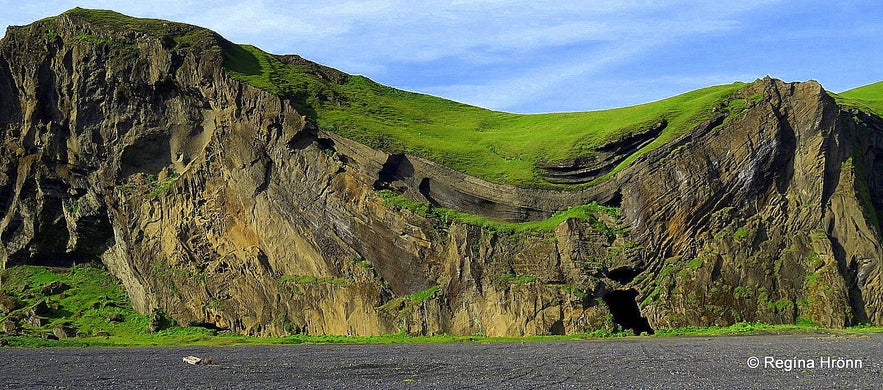
Hjörleifshöfði cape South-Iceland
Ingólfur worshipped the old Nordic gods and sought information about his destiny, whereas Hjörleifur never wanted to worship seeing that he had converted to Christianity. The oracle told Ingólfur to sail to Iceland.
The brothers-in-law sailed on 2 ships to Iceland. Hjörleifur carried his loot on his ship, but Ingólfur carried their common stock.
They sailed together until they saw Iceland, then they separated. Ingólfur came ashore by Ingólfshöfði promontory, which got his name, but Hjörleifur came ashore further west by Hjörleifshöfði, which got his name.
At that time there was a fjord by Hjörleifshöfði. Hjörleifur built two farmhouses (huts), one of them 18 fathoms and the other one 19 fathoms. Here he spent the winter with his workers and slaves and their women.
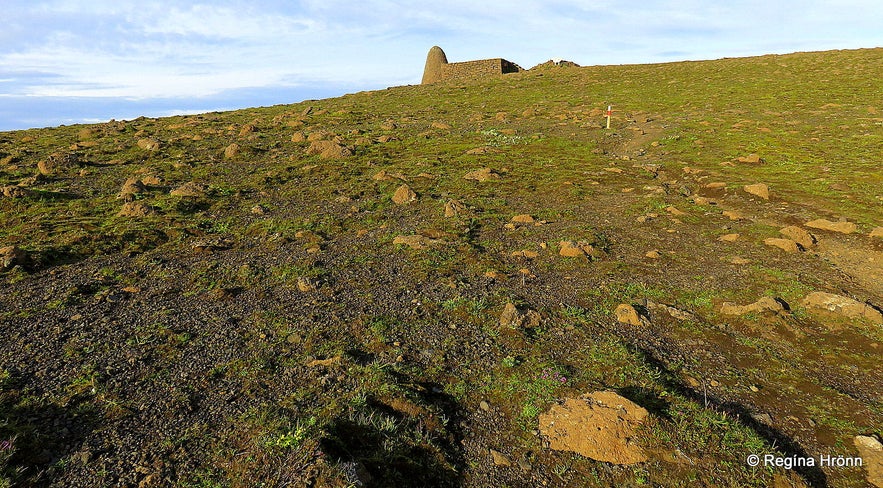
Hiking to the top of Hjörleifshöfði
Next spring he wanted to cultivate the land. He only had one ox so he forced his slaves to pull the plough. This angered the slaves and they killed the ox and blamed it on a brown bear. Seeing that they had just arrived in Iceland and had only stayed here for one winter, they did not know that brown bears don‘t exist in Iceland.
As Hjörleifur and his men went to look for the brown bear in the woods – yes, we had woods back then - the slaves attacked them and killed them all – the men were as many as the slaves.
The slaves then fled with the women and the commodity in a boat to the islands, which can be seen in the south from Hjörleifshöfði, and settled there for a while. They knew that the Ingólfur, the blood brother of Hjörleifur, would revenge his death as soon as he would find out about the killings.
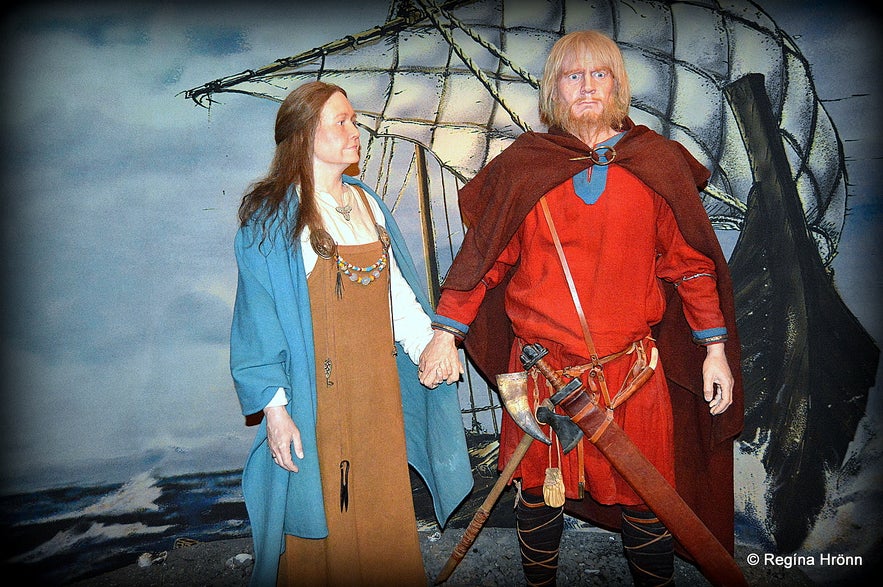
I took this photo at the Saga Museum in Reykjavík - Hallveig and Ingólfur, which I recommend visiting
Ingólfur, who was staying at Ingólfshöfði promontory, sent his slaves, Vífill and Karl, to look for his high seat pillars. Ingólfur had thrown his high seat pillars from the Viking ship and was going to settle land where the pillars would be found. When his slaves reached Hjörleifshöfði they found Hjörleifur dead.
They went back to Ingólfur to tell him this bad news. In the photo above, which I took at the Saga Museum in Reykjavík, you can see how Ingólfur and Hallveig, his wife, are depicted.
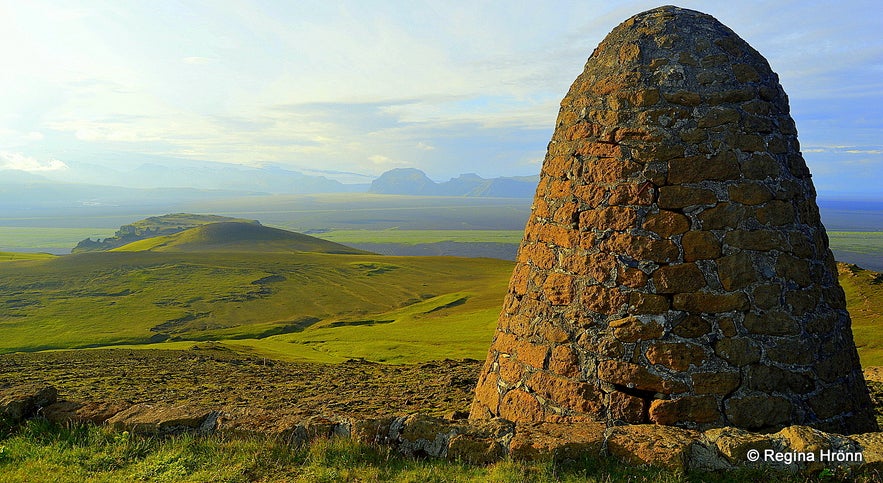
The big cairn on top of Hjörleifshöfði
Ingólfur went to Hjörleifshöfði and as he saw Hjörleifur lying there dead he said: "Lítið lagðist hér fyrir góðan dreng, er þrælar skyldu að bana verða, og sé eg svo hverjum verða, ef eigi vill blóta." Meaning: "What a destiny for a good lad, that he was killed by his slaves. I now see what happens to people who don‘t want to worship the Nordic gods“.
Ingólfur saw to it that Hjörleifur and his men were buried and then hiked up Hjörleifshöfði and saw the islands in the south. He figured that the slaves might have fled to these islands as the boat was missing. He sailed with his men to the islands and found the slaves as they were dining. 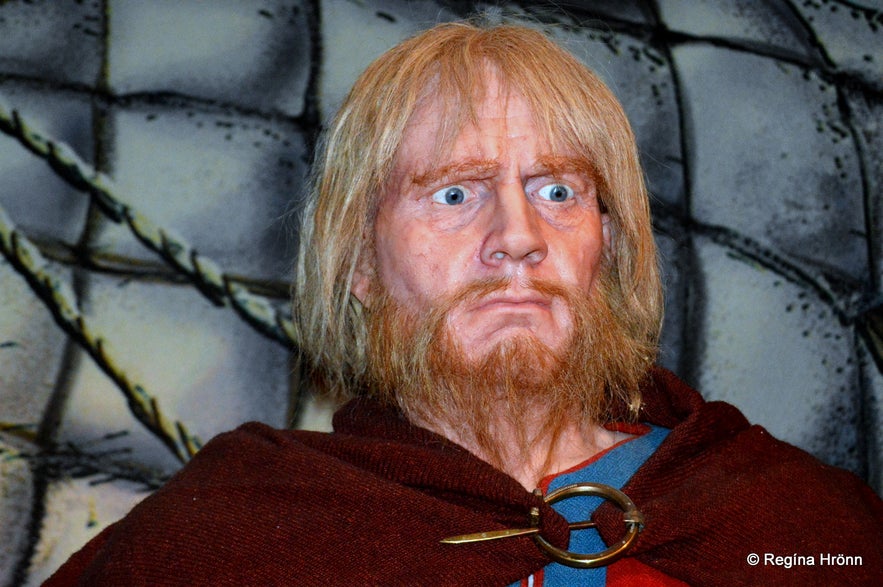
Photo of Ingólfur taken at the Saga Museum
The slaves panicked and fled, but Ingólfur killed them all. Since then these islands have been called Vestmannaeyjar islands or the Westman islands as the slaves were Irish or Westmen as they were often called. In the Westman islands, you will find one of the largest Puffin nesting areas in the world.
Ingólfur and his men brought with them the wives of the men who had been killed (Hjörleifur and his men) back to Hjörleifshöfði and Ingólfur stayed there for another winter.
The third winter he spent by Mt. Ingólfsfjall, just west of Selfoss and Ölfusá river, and the mountain was named after him.

Photo of Hallveig taken at the Saga Museum
The slaves of Ingólfur found his high pillars by Arnarhvoll in what is now Reykjavík, the capital city of Iceland, and next spring Ingólfur settled Reykjavík with his wife Hallveig.
In my photos above and below you will see Ingólfur and Hallveig as they are depicted at the Saga Museum in Reykjavík, which I recommend visiting during your Iceland visit.
After Hjörleifur and his men's killings "no one dared to settle land there because of supernatural beings".
The Viking who finally settled Hjörleifshöfði promontory was Ölver Eysteinsson, the son of Eysteinn Drangakarl in Fagridalur valley.
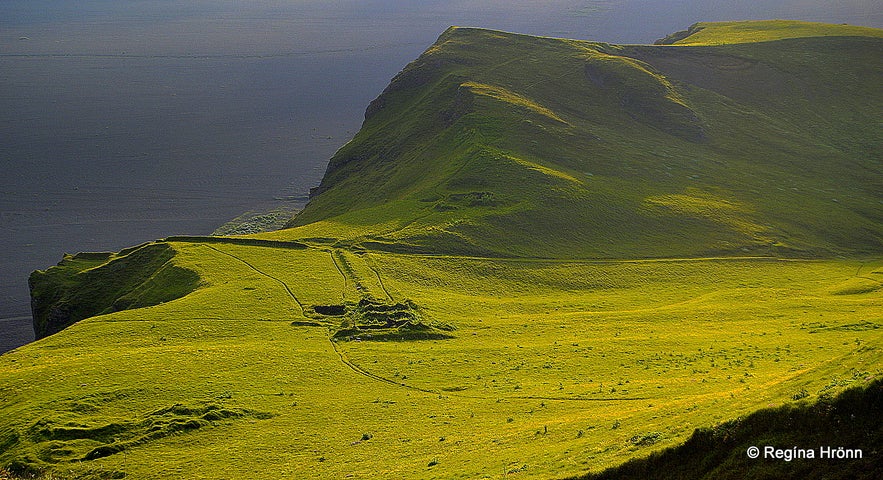
Ruins of the old farm on Hjörleifshöðfi
I found an account in Þjóðsögur Jóns Árnasonar - the Collection of Folklore of Jón Árnason, which I often refer to in my travel-blogs, and translated it into English:
"By now Katla had covered the area around Hjörleifshöfði with thick sand, like in other places on Mýrdalssandur sand plains and destroyed all the traces of human habitation – but now Hjörleifshöfði is a tall mountain. At the highest peak of Hjörleifshöfði stands a large pile of rocks and on top of it, a cairn has been stacked of rocks. It is believed to be true that beneath the cairn Hjörleifur rests.
Folklore tells us that a farmer living on Hjörleifshöfði dreamt Hjörleifur, who asked him to move his grave up to the peak of Hjörleifshöfði, where the sun first and last shone. And where the grave is now, on the highest peak of Hjörleifshöfði, the sun shines first when it comes up and last when it goes down.
Hjörleifur promised the farmer in his dream that he would have luck in his life if he did this for him. This turned out to be true as the farmer had great luck in his life both on land and sea".
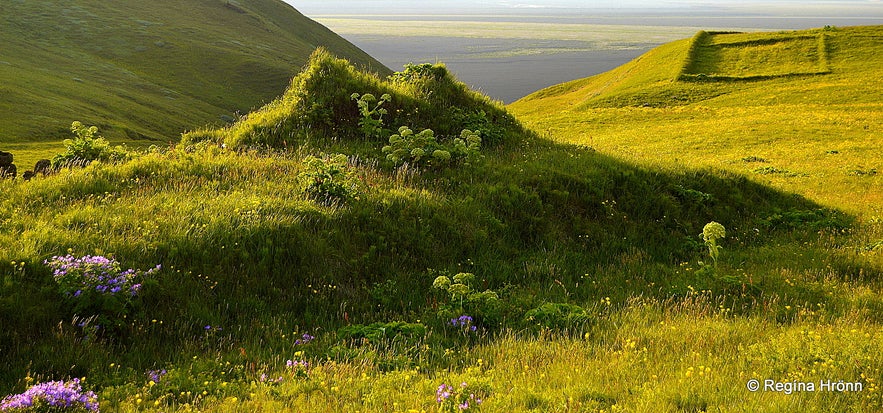
Ruins on Hjörleifshöfði cape
It was a common belief that a spell has been put on Hjörleifshöfði - that whoever lives on it will blossom for 20 years, but after that things would start to go downhill. It cannot be denied that things have gone exactly this way since the 18th century.
When a new farmer had come to live in Hjörleifshöfði and had added to the cairn and looked after it, almost always did he have luck shortly after.
On the other hand, when a farmer had been over 20 years in Hjörleifshöfði and a stone was added to the cairn, the farmer lost one of his cattle or at least one of his domestic animals.
Benedikt Þórðarson, who later drowned in Mýrdalssandur, once came to Hjörleifshöfði in heavy snow and knew exactly where he was going, but when he had hiked up Hjörleifshöfði and was heading for the farm he all of a sudden got lost and found himself by Hjörleifsleiði burial mound - which is much higher up than the old farm.
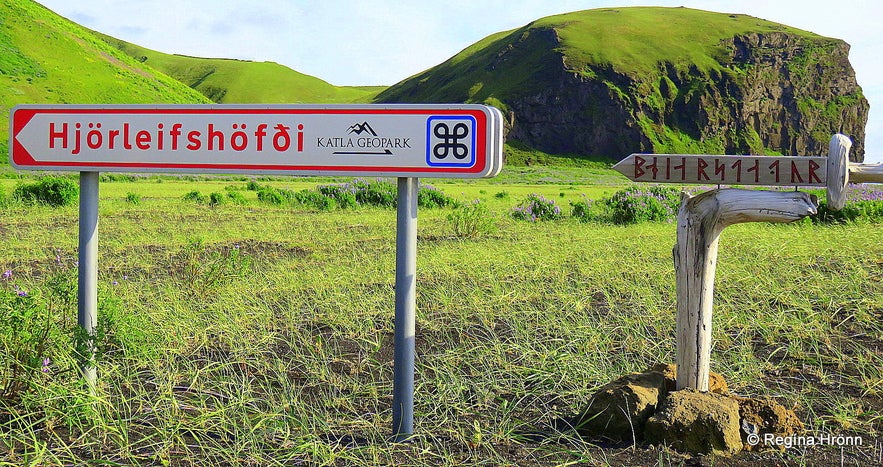
Signs by Hjörleifshöfði
He meant to head in the direction of the farm from the burial mound, but he soon got lost again and didn't know where he was going until he was back at the burial mound; it went like this three times. Then Benedikt wrote 3 verses, 2 of which are now lost, but the first one goes like this:
„Er hér haugur uppgjörður,
ýtar hafa í minni,
hér var grafinn Hjörleifur
hraustur í fornöldinni.“
Which translates into English something like this:
A burial mound has been rebuilt here,
Men will remember
Here was buried Hjörleifur
A valiant man from antiquity."

Hjörleifshaugur burial mound
Haraldur hárfagri - Haraldur Fairhair had been the king of Norway for 12 years when Ingólfur and Hjörleifur left Norway to settle in Iceland. Many more Norwegians fled the dictatorship of Harald later on and became settlers in Iceland.
Ingólfur is the best known Viking settler as he was the first to settle in Iceland - he settled in Reykjavík, which was later to become Iceland's capital city – many Norwegian Vikings followed in his footsteps and settled in other parts of Iceland.

The statue of Ingólfur Arnarson in Reykjavík
I am going to tell you about these Vikings later on - their story, which has been written in both the Book of Settlement and our Icelandic Sagas, is very colourful and sometimes very bloody.
I have written another travel-blog about the bloody Viking battles in Skagafjörður when the biggest Viking clans of Iceland fought each other.
Ingólfur Arnarson (844) and Hallveig Fróðadóttir (850) are my ancestors and I am the 30th generation from them.
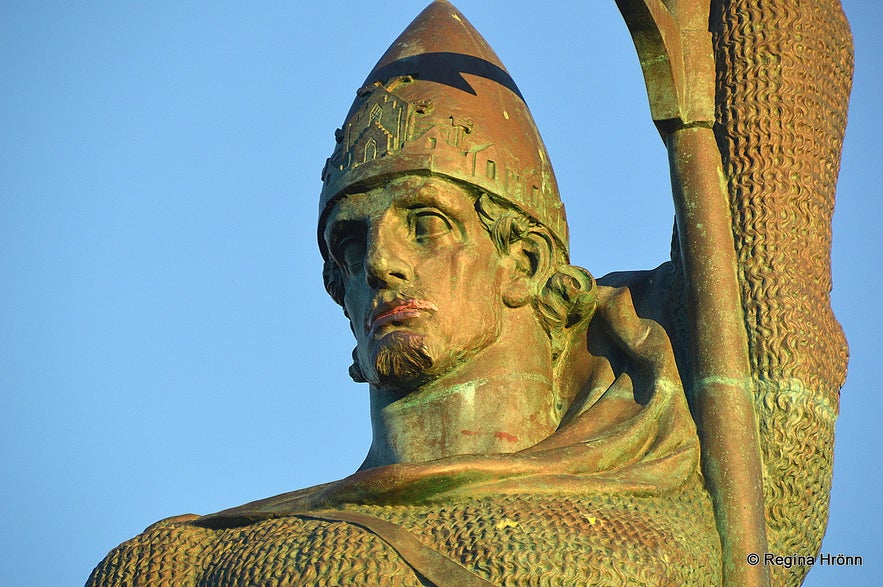
The statue of Ingólfur Arnarson in Reykjavík
Isn't this an interesting story of a promontory most people pass on their way to other better-known sights in South Iceland?
I have written 2 travel-blogs about Hjörleifshöfði and in my second part Hjörleifshöfði in South-Iceland - Part II - the Hike, the Inhabitants and the Yoda Cave, you will learn more about the people who inhabited Hjörleifshöfði, their grave on the highest peak next to Hjörleifshaugur burial mound, the monument on this peek in the liking of a big cairn, built by Danish surveyors in the first decade of the twentieth century - and my hike on the promontory.

From Hjörleifshöfði you can drive down to the southernmost point of the mainland of Iceland, Kötlutangi spit.
Hjörleifshöfði is on the coast of South-Iceland, on Mýrdalssandur beach, just east of the village of Vík.
From Vík, drive along ring-road 1, then turn onto the road marked Hjörleifshöfði.
Hjörleifshöfði was for sale from 2016-2020 when it was finally sold. I hope that access will not be restricted to the hike and the burial mound on top of Hjörleifshöfði.
Here is the location of Hjörleifshöfði on the map. GPS: 63°25'13.2"N 18°44'58.0"W
I have written another travel-blog about Viking Ruins and Burial Mounds I have visited on my Travels in Iceland - which is a list of all the archaeological sites and burial mounds, which I have visited in Iceland.
And a travel-blog about: The Viking Settler Ingólfur Arnarson, Mt. Ingólfsfjall and Ingólfsskáli Turf Longhouse in South-Iceland
Have a lovely time in Iceland :)
其他有意思的博客
冰岛最浪漫的角落
对于很多人,遥远的冰岛有着世界尽头的神秘,有着区别于巴黎、马尔代夫、自成一体的浪漫。没有埃菲尔铁塔和蒂凡尼,没有热带沙滩,而是在冰川、火山、苔藓地的背景下蜜月旅拍、婚拍,甚至举办一场冰岛婚礼。来冰岛旅行,多是要跨千山万水、飞跃大洋大陆,很有一点“万水千山陪你走过”的史诗感。难怪很多人说,光是冰岛二字,就足够浪漫了。 冰岛虽然不大,但是地貌极其丰富,不同的自然景观自然有不同的气质。这一篇,就挑阅读更多从极光观测到摄影-到底该不该来冰岛看极光
很多朋友都想来冰岛看极光,但是冰岛到底适不适合看极光呢?几月、什么季节能看到极光?是不是一定要参加北极光旅行团?如何能拍摄出美丽的极光照片呢?在冰岛住了好几年了,从刚开始逢极光必出门,到如今家里阳台就能看极光,我对在冰岛看极光的了解和经验,也算得上大半个专家了,且听我娓娓道来吧。 到底该不该来冰岛看极光呢?最坦诚的答案是,不要只为了看极光而看极光。 极光原理 太阳活动→太阅读更多
迷失冰岛的米湖游览推荐|不只有温泉的地热宝藏区
我在冬夏秋均到访过米湖,看过米湖的不同面。一直以来,米湖到底值不值得去是很多游客争论的问题。有些人觉得这里是来冰岛旅行的必去目的地,有些人则说米湖“太丑了”,连照片都不想多拍几张。那米湖到底值不值得来呢?到底怎么玩呢? 米湖的风景 北部的米湖,因地理位置相距首都雷克雅未克略远,很多来冰岛的短途游客选择放弃,其实米湖应该是和黄金圈、南岸沿线至冰湖齐名的冰岛景色,这里冷热相融,可谓最冰岛,尤其阅读更多

将冰岛最大的旅行平台下载到您的手机中,一站式管理您的整个行程
使用手机摄像头扫描此二维码,然后点击显示的链接,将冰岛最大的旅行平台添加到您的手机中。输入您的电话号码或电子邮件地址,以接收包含下载链接的短信或电子邮件。


















